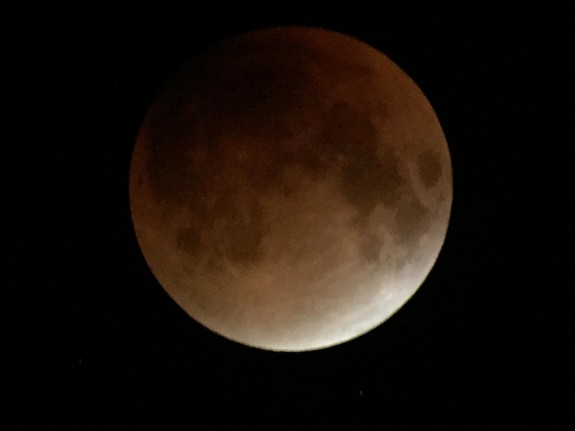[An eclipsed moon with a reddish appearance; image courtesy AP]
Discussion
Viewing conditions on Sunday night are certainly in question for much of the Mid-Atlantic region, but something that hasn’t taken place in 32 years and won’t take place again for another 18 years will occur:
a total lunar eclipse that coincides with a “supermoon”.
On Sunday (September 27, 2015) Earth's shadow will begin to dim the "supermoon" slightly, beginning at 8:11 p.m. EDT. The total eclipse will start at 10:11 p.m. EDT Sunday evening and will last one hour and 12 minutes. It will be visible across North and South America, Europe, Africa, and parts of West Asia and the eastern Pacific.
A “supermoon” just means the moon looks a bit bigger than usual since it is closer to Earth compared to normal – as much as 50,000 km closer than other full moons. Specifically, a “supermoon” is defined as when the new or full moon comes within 224,834 miles of Earth as measured from the centers of the moon and Earth. There are six "supermoons" this year which are 12 to 14 percent brighter than a full moon in its most distant approach to Earth. There have been just five “supermoon” events since 1900 (in 1910, 1928, 1946, 1964 and 1982).
An eclipsed moon takes on a red appearance (hence reference to "blood" moon) as most of the light illuminating the moon passes through the stratosphere where it is reddened by scattering. Red is not necessarily the only visible color, however. Light that passes through the upper stratosphere penetrates the ozone layer which absorbs red light and actually makes the passing light ray bluer. This can be seen as a soft blue fringe around the red core of Earth’s shadow – usually best seen during the first and last minutes of totality.
This will be the last total lunar eclipse anywhere on Earth until 2018. In fact, there will actually be a total solar eclipse (in August 2017) visible in the USA before the next total lunar eclipse.







